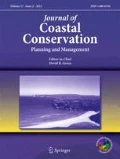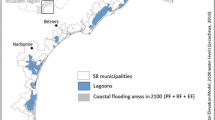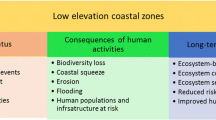Abstract
Coastal zones experience increased rates of coastal erosion, due to rising sea levels, increased storm surge frequencies, reduced sediment delivery and anthropogenic transformations. Yet, coastal zones host ecosystems that provide associated services which, therefore, may be lost due to coastal erosion. In this paper we assess to what extent past and future coastal erosion patterns lead to losses in land cover types and associated ecosystem service values. Hence, historical (based on CORINE land cover information) and projected (based on Dynamic and Interactive Vulnerability Assessment - DIVA - simulations) coastal erosion patterns are used in combination with a benefits transfer approach. DIVA projections are based on regionalized IPCC scenarios. Relative to the period 1975–2050, a case study is provided for selected European coastal country member states. For historical (1975–2006) coastal erosion trends, we observe territory losses in coastal agricultural, water body and forest & semi-natural areas – total coastal erosion equaling over 4,500 km2. Corresponding coastal ecosystem service values decrease from about €22.3 billion per year in 1975 to about €21.6 billion per year in 2006. For future (2006–2050) coastal erosion projections, total territory losses equal between ~3,700 km2 and ~5,800 km2 – coastal wetland areas being affected most severely. Corresponding coastal ecosystem service values decrease to between €20.1 and €19.4 billion per year by 2050. Hence, we argue that the response strategy of EU member states to deal with coastal erosion and climate change impacts should be based on the economic as well as the ecological importance of their coastal zones.
Similar content being viewed by others
Notes
Relative to 1995, the B1-regionalized and A1Fi-regionalized scenarios correspond with a global mean sea-level rise of 0.35 and 1.07 meters by 2100, respectively (Nakicenovic and Swart 2000).
References
Alves F, Roebeling P, Pinto P, Batista P (2009) Valuing ecosystem service losses from coastal erosion using a benefits transfer approach: a case study for the Central Portuguese coast. J Coast Res 56:1169–1173
Bergstrom JC, De Civita P (1999) Status of benefit transfer in the United States and Canada: a review. Can J Agric Econ 47(1):79–87
Bosello F, Roson R, Tol RSJ (2006) Economy-wide estimates of the implications of climate change: sea-level rise. Environ Resour Econ 37:549–571
Bossard M, Feranec J, Otahel J (2000) CORINE land cover technical guide – addendum 2000. EEA Technical Report No. 40/2000. European Environment Agency, Copenhagen, p 105
Brenner J, Jiménez JA, Sardá R, Garola A (2010) An assessment of the non-market value of the ecosystem services provided by the Catalan coastal zone, Spain. Ocean Coast Manag 53:27–38
Brouwer R (2000) Environmental value transfer: state of the art and future prospects. Ecol Econ 32:137–152
Costanza R, Arge R, Groot R, Farber S, Grasso M, Hannon B, Limburg K, Naeem S, O’Neill R, Paruelo J, Raskin R, Sutton P, Belt M (1997) The value of the world’s ecosystem services and natural capital. Nature 387:253–259
Darwin RF, Tol RSJ (2001) Estimates of the economic effects of sea level rise. Environ Resour Econ 19:113–129
De Groot RS, Alkemade R, Braat L, Hein L, Willemen L (2010) Challenges in integrating the concept of ecosstems services and values in landscape planning, management and decision making. Ecol Complex 7:260–272
Downing M, Ozuna T (1996) Testing the reliability of the benefit function transfer approach. J Environ Econ Manag 30:316–322
EEA (2002) Corine land cover 1990 (CLC1990) and Corine land cover changes 1975–1990 in a 10 km zone around the coast of Europe. http://www.eea.europa.eu/data-and-maps/data/corine-land-cover-1990-clc1990-and-corine-land-cover-changes-1975-1990-in-a-10-km-zone-around-the-coast-of-europe. Accessed 28 September 2009
EEA (2006a) The changing faces of Europe’s coastal areas. EEA Report No. 6/2006. European Environment Agency, Copenhagen, p 107
EEA (2006b) Urban sprawl in Europe – the ignored challenge. EEA Report No. 10/2006. European Environment Agency, Copenhagen, p 56
EEA (2009a) Corine land cover (CLC1990) 100 m – version 12/2009. http://www.eea.europa.eu/data-and-maps/data/corine-land-cover-clc1990-100-m-version-12-2009. Accessed 28 September 2009
EEA (2009b) Corine land cover (CLC2000) 100 m – version 12/2009. http://www.eea.europa.eu/data-and-maps/data/corine-land-cover-2000-clc2000-100-m-version-12-2009. Accessed 28 September 2009
EEA (2009c) Corine land cover (CLC2006) 100 m – version 12/2009. http://www.eea.europa.eu/data-and-maps/data/corine-land-cover-2006-clc2006-100-m-version-12-2009. Accessed 28 September 2009
Eurosion (2004) Living with coastal erosion in Europe: sediment and space for sustainability. EUROSION project, Directorate General Environment, European Commission, p 54
Groothuis PA (2003) Benefit transfer: a comparison of approaches. Growth Change 36(4):551–564
Hinkel J, Klein RJT (2009) Integrating knowledge to assess coastal vulnerability to sea-level rise: the development of the DIVA tool. Glob Environ Chang 19:384–395
Ionescu C, Klein RJT, Hinkel J, Kavi Kumar KS, Klein R (2009) Towards a formal framework of vulnerability to climate change. Environ Model Assess 14:1–16
Knogge T, Schirmer M, Schuchardt B (2004) Landscape-scale socio-economics of sea-level rise. Ibis 146:11–17
Leatherman SP, Nicholls RJ (1995) Accelerated sea-level rise and developing countries: an overview. J Coast Res 14:1–14
Liu S, Costanza R, Farber S, Troy A (2010) Valuing ecosystem services: theory, practice and the need for a transdisciplinary synthesis. Ann N Y Acad Sci 1185:54–78
MA (2005) Ecosystems and human well-being: current state and trends. Island Press, Washington DC, Millennium Ecosystem Assessment, p 948
Martinez MI, Intralawan A, Vázquez G, Pérez-Maqueo O, Sutton P, Landgrave R (2007) The coasts of our world: ecological, economic and social importance. Ecol Econ 63:254–272
Nakicenovic N, Swart R (2000) Emissions scenarios – special report of Working Group III of the intergovernmental panel on climate change. Cambridge University Press, Cambridge
Nicholls RJ (2002) Rising sea levels: potential impacts and responses. In: Hester RE, Harrison RM (eds) Global Environment Change. Issues in Environmental Science and Technology, vol 17. Royal Society of Chemistry, Cambridge, pp 83–107
Nicholls RJ, Hoozemans FMJ (1996) The Mediterranean: vulnerability to coastal implications of climate change. Ocean Coast Manag 31(2–3):105–132
Nicholls RJ, Tol RSJ (2006) Impacts and responses to sea-level rise: a global analysis of the SRES scenarios over the twenty-first century. Phil Trans Math Phys Eng Sci 364:1073–1095
Nicholls R, Hoozemans F, Marchand M (1999) Increasing flood risk and wetland losses due to global sea-level rise: regional and global analyses. Glob Environ Chang 9:69–87
Petoukhov V, Ganopolski A, Brovkin V, Claussen M, Eliseev A, Kubatzki C, Rahmstorf S (2000) CLIMBER-2: a climate system model of intermediate complexity. Part I: model description and performance for present climate. Clim Dyn 16(1):1–17
Roebeling PC, Coelho CD, Reis EM (2011) Coastal erosion and coastal defense interventions: a cost-benefit analysis. J Coast Res 64:1415–1419
Stive MJ, Capobianco M, Wang Z, Ruol P, Buijsman M (1998) Morphodynamics of a tidal lagoon and the adjacent coast. In: Dronkers J, Scheffers M (eds) Physics of estuaries and coastal seas. Balkema, Rotterdam, pp 397–407
UN (2005) Human development report – international cooperation at a crossroads: aid, trade and security in an unequal world. United Nations, p 372
Van Goor M, Zitman T, Wang Z, Stive M (2003) Impact of sea-level rise on the morphological equilibrium state of tidal inlets. Mar Geol 202:211–227
Wilson MA, Hoehn JP (2006) Valuing environmental goods and services using benefit transfer: the state-of-the art and science. Ecol Econ 60:335–342
World Bank (2009) World development indicators 2009. World Bank, Washington. CD-ROM
Yohe GW, Schlesinger ME (1998) Sea-level change: the expected economic cost of protection or abandonment in the United States. Clim Chang 38:447–472
Zhang K, Douglas B, Leatherman S (2004) Global warming and coastal erosion. Clim Chang 64:41–58
Acknowledgments
We thank the Centre for Environmental and Marine Studies (CESAM) at the University of Aveiro for facilitating this research. Also, we would like to thank JCC anonymous referees for their helpful comments on an earlier version of this paper.
Author information
Authors and Affiliations
Corresponding author
Rights and permissions
About this article
Cite this article
Roebeling, P.C., Costa, L., Magalhães-Filho, L. et al. Ecosystem service value losses from coastal erosion in Europe: historical trends and future projections. J Coast Conserv 17, 389–395 (2013). https://doi.org/10.1007/s11852-013-0235-6
Received:
Accepted:
Published:
Issue Date:
DOI: https://doi.org/10.1007/s11852-013-0235-6




